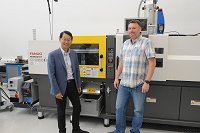Fanuc flexes its muscles in Europe
02.11.2018
Fanuc had been ahead of its time when in 1985 they started producing special injection moulding machines. While European producers developed hydraulic machines, the Japanese company focussed on Autoshot all-electric drive machines, which developed later into today`s Roboshot models. Today European makers also offer the cost-effective all electric models, but it took quite a while for them to pick up.
 There is a view prevalent in the market that the predominant production of all-electric IMMs in Japan originated from prohibition of indoor hydraulic oil storage in the country’s industry in the 1950’s – preventive fire protection regulations. When pressed on this point, Fanuc Europe Corporation President & CEO Shinichi Tanzawa, preferred to stress all-electric IMM advantages over hydraulic and hybrid drives of higher efficiency in energy consumption, higher accuracy and much less maintenance. One example of this dedication is a new 450-tonne clamping force Roboshot presented at Fakuma.
There is a view prevalent in the market that the predominant production of all-electric IMMs in Japan originated from prohibition of indoor hydraulic oil storage in the country’s industry in the 1950’s – preventive fire protection regulations. When pressed on this point, Fanuc Europe Corporation President & CEO Shinichi Tanzawa, preferred to stress all-electric IMM advantages over hydraulic and hybrid drives of higher efficiency in energy consumption, higher accuracy and much less maintenance. One example of this dedication is a new 450-tonne clamping force Roboshot presented at Fakuma.
Tanzawa comments “Although everyone in Europe talks about the environment and energy consumption, the trend still hasn’t fully worked through to the European IMM market as it has in Japan. But once that happens, I am sure we can grow a lot more”. Today, with Fanuc operating independently in Europe, the practical limit remains at or close to 450 tonnes, as electric motors needed for much higher tonnages become cumbersome: “we will not use hydraulic drive on our IMMs”, Tanzawa stressed.
Tanzawa added “Our product itself has high quality and durability. We monitor mean time between failure (MTBF). As we have also experienced in our CNC machine tool and robot businesses, our MTBF for the Roboshots is not months, but typically more than 10 years”, the only prerequisite being a proper maintenance after installation. In September 2018, Tanzawa said, Fanuc had installed an accumulated total of 6,500 Roboshots in Europe, 60,000 worldwide.
Tanzawa says all-electric IMMs now account for a 30% market share in Europe, with Fanuc accounting for about 20% of all-electric IMMs supplied in Europe. He admits sales need more commitment in Austria and Germany due to strong presence of local IMM producers. While most but not all European producers have meanwhile also got onto the all-electric ‘bandwagon’ after initial reserve, they still retain hydraulic drive models.
Robots is Fanuc’s largest area with 550,000 robots installed worldwide and 13,000 robots/year sold in Europe accounting for 60% of the company’s European business. “It depends very much on automotive projects, our biggest volume business, which fluctuates a lot”, Tanzawa explains. To the present day, the company has also supplied more than four million CNC control systems as well as 18 million servodrives worldwide.
Although Fanuc has started offering collaborative robots (cobots), which are painted green as opposed to the Fanuc corporate yellow on all other equipment, Tanzawa says that such cobots, working with humans with protective sensors without needing protective fencing, isn’t a big volume business yet, “even if some people want to make it a trend”. He added: “We are a little bit shy in marketing cobots, as we want to go step by step. It is hard to say which way the trend will go, but we can be relaxed, as we have a great lineup of conventional robots as well as cobots. Many European customers are checking our cobots”. Tanzawa claims, “Unlike some very cheap competitors’ cobots, ours have a high accuracy and durability”.
The next largest area after robots is the CNC machine tool business with Robodrill, Robocut as well as Robonano (debut in 2018) machines for the metalworking industry in general and also for mould making in the plastics industry. Four million systems have been installed worldwide. The machine tool and Roboshot businesses are still increasing, but at a lower rate than with robots. Although Tanzawa sees most potential in robots, where Fanuc dominates the market in Japan and America, the company has a more challenging task in Europe, where ‘local’ producers are serious competitors, with their robots also widely used with IMMs.
Although a free trade agreement signed 17th July 2018 between the EU and Japan benefits Fanuc’s business in Europe, Tanzawa says “the import duty for the products we import from Japan has not been very high”. More important for the company has been a strong, fast and good service approach during the past few years, as a priority over sales. The philosophy behind this is that better service benefits customers, leading them to prefer Fanuc machines in the future, also due to high quality, reliability and longevity of the machines.
Tanzawa says he has been growing the entire organisation by 2-digit percentages since he became CEO & President at Fanuc Europe in 2016, “but our revenue is growing even faster”. He says he inherited a situation of most volume coming from Western Europe, but sees much potential in faster growing Central and Eastern European countries, where automation is now becoming increasingly important, due both to investment by Western European companies and shortages of qualified staff. Fanuc wants to hire high quality staff for its offices in Romania and Slovakia (both established in 2017) and Serbia (opening in 2018).
Within 7,000 employees worldwide, Fanuc has 1,450 employees in Europe and 21 subsidiaries. Most staff (300) are in Germany, followed by France, Italy, UK, and Spain. Other subsidiary offices are smaller, with 30-50 employees, with 40 each in Poland and Hungary, where a new 4,000 sqm office was recently built: “Installing robots and IMMs requires a lot of space and space is needed for customer training too”, Tanzawa explains, as exemplified by the new “Fanuc academy” in Stuttgart, Germany.
Fanuc also retains and seeks agencies in countries with subsidiary offices. It is all worthwhile, as although Tanzawa can’t reveal the value of the IMM business, he says consolidated revenue of the entire Fanuc group in Europe as a whole amounts to around one billion Euro, or 15-25% of worldwide revenue, depending on fluctuations in other markets like China, etc.
Tanzawa admits, “We haven’t done enough on communication to the customer in the past, we aim to do it in a better way now”. Also he wants to improve the internal communication between Fanuc robot, machine tool and IMM businesses. This would provide more benefits for customers, including working closely with the new robotics branch set up in Regensburg, Germany in August 2018.
But although Tanzawa seeks to benefit customers with overall Fanuc “plug-and-play” solutions, it is not easy to offer, as robots are sold largely via system houses and Tanzawa does not really want to interfere with that. This makes it difficult to target sales to end-users, who can potentially use different types of Fanuc equipment.
Potential benefits are clear, as seamless combination of IMMs and robots enables plastics processors to work round the clock in “lights-out shifts” for higher output and at lower cost.
And although Roboshots are by no means inexpensive, Fanuc’s European technical Support Manager, Darren Whittall, points to their low total cost of ownership, on account of low maintenance and long life, not to forget inconvenience and costs associated with hydraulic IMMs in handling filters and keeping the machines and mould shop clean. Tanzawa added that “our IMMs are therefore cheaper, despite higher initial cost, when you look at the long-term return on investment [ROI]”. I am sure, when customers get benefits from Fanuc IMMs, they don’t want to change, as they already trust the machines”.
An important aspect to high efficiency and low cost production is also working to Industry 4.0 Internet of the Things (IoT) principles. Fanuc started promoting its own version in Japan in 2017: FIELD (Fanuc Intelligent Edge Link & Drive), and it will come to Europe in 2019. FIELD focuses on inter-equipment communication via fast in-factory networks, as Tanzawa says this is faster in data collection than cloud-based solutions and better addresses customer concerns on data security.
Fanuc developed its own application within FIELD predicting when e.g. motor and robot faults and excessive deviations may occur in future. It encourages using Fanuc control system analysis information with deep learning artificial intelligence (AI) for this purpose. Whittall says this results in zero robot and IMM downtime (Fanuc’s ZDT approach), by ensuring spare part availability when needed, for maximum machine utilisation, as well as “ensuring that a robot doesn’t do something detrimental to its own health”.
Tanzawa is not concerned about the effect of Brexit on UK business. To the contrary, customer enquiries show it is already making many UK processors realise how much they need automation to maintain and improve competitiveness. Whittall said “time will tell, but we will continue our UK business, as long as there are users of FANUC products”. He stressed that Fanuc has received large orders in the UK since the Brexit referendum, supported by a large expansion of facilities at Fanuc UK.
Tanzawa found Fanuc’s overall potential in Europe was higher than expected when he was appointed CEO, having worked in Fanuc’s European robotics business beforehand. He summarises “Financial strength is natural for Fanuc, as it has a good amount of cash: I want to use it to invest. That will give confidence to customers, more importantly to the employees too, so we can hire good quality staff”.
High cash reserves enable high inventories, with e.g. 3,000 robots stocked in Luxembourg compensating for 1.5 months shipment time from Japan. Fanuc had been cutting robot and IMM inventories before Tanzawa became CEO, but he then immediately took action to boost stock levels. “As long as we have products in stock, I am convinced we can sell them standing up to and outperforming competition also on delivery time”, Tanzawa explains.





































